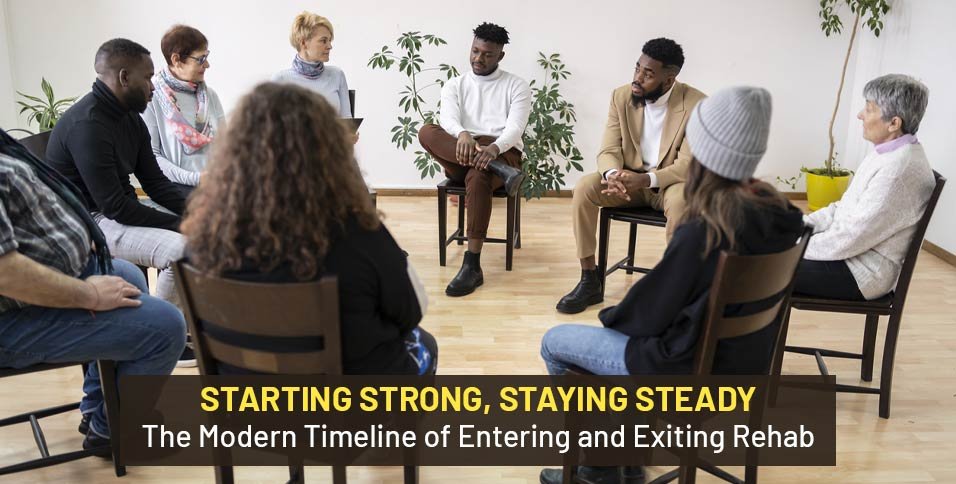There’s a certain rhythm to recovery that rarely gets talked about outside of those who’ve lived it. Walking through the doors on day one is nothing like walking out weeks or months later, and yet both moments mark the start of something new. The in-between, where structure meets self-discovery, often sets the tone for what happens once you’re back in the flow of daily life. In 2025, the process has evolved — not just in clinical methods, but in the way people and communities shape the journey from the first intake meeting to long after the last group session.
Settling Into The First Days
The early stretch inside rehab can feel like entering a space where time moves differently. There’s the adjustment to schedules, group meetings, and learning the faces of people who’ll become part of your daily routine. Medical assessments and intake conversations help set a personal baseline, giving the care team a sense of where to begin. Meals and sleep take on new importance. The body notices the shift before the mind catches up, and often, the initial fatigue gives way to a clearer, steadier energy.
Structure is a big part of this stage. Most programs keep days mapped out so there’s little room for decision fatigue or the kind of downtime that can turn into overthinking. Therapeutic activities start early — from one-on-one counseling to group discussions where people compare experiences and talk through challenges. For many, this is when the first sparks of trust appear. It’s not instant, but it’s noticeable when someone stops sitting near the door and starts leaning in during conversation.
Finding Your Pace Inside
After the first couple of weeks have passed, routines will begin to feel less like rules and more like anchors you’re happy to have. There’s a predictable rhythm to waking up, attending therapy sessions (group and one-on-one), and spending time in serious reflection. Some people take to journaling, while others find relief in art, movement, or simply sharing more during group talks. It’s often around this time that personal goals sharpen. Instead of focusing on what’s wrong, the attention shifts to what’s possible.
Not all approaches look the same, and that variety matters. Some programs integrate holistic practices like meditation and nutrition workshops, while others draw from faith-based treatment models that weave spiritual elements into recovery work. Having multiple paths allows people to connect with what resonates most, which can make the difference between simply participating and fully engaging. Peer bonds deepen here too, as shared progress creates a sense of camaraderie that can carry well beyond discharge.
Preparing For The Transition Out
The last stretch inside rehab isn’t about winding down so much as looking ahead. Counselors and case managers often help map out a transition plan that covers the basics — housing, continued therapy, support group connections — while also accounting for individual needs like work schedules, family responsibilities, or ongoing medical care.
This stage can be a mix of excitement and uncertainty. The idea of freedom is obviously appealing, but the safety of a structured environment is also (and sometimes surprisingly) hard to leave behind. That’s the reason that many programs now offer step-down options, like partial hospitalization (PHP) or intensive outpatient (IOP) schedules, to bridge the gap. It’s a way to ease back into real-world responsibilities without feeling like you’ve been dropped into deep water before you’re ready.
There’s also a significant and important focus on relapse prevention, though the language has shifted in recent years. It’s less about fear of failure and more about building practical coping strategies. Identifying early warning signs, knowing who to call, and keeping a flexible plan in place turns the concept into something active rather than a looming threat.
Life After The Door Closes Behind You
Leaving rehab is a milestone, but it’s not a finish line. The first few weeks back outside can feel full of both opportunity and challenge. Familiar places might hold old triggers that will set you back, and familiar people may not fully understand the changes you’ve made. This is where aftercare plans earn their worth. Continuing therapy, attending support meetings, and staying connected to positive influences help ground those early days.
For a lot of people, this period includes moving into sober living homes, which offer structure without the intensity of full-time treatment. These environments provide a bridge between rehab and total independence, keeping accountability in place while encouraging personal growth. It’s also when new routines outside of therapy start taking shape — work schedules, exercise habits, or hobbies that didn’t have space before.
Support systems prove themselves here. Whether it’s a sponsor, a trusted friend, or a sibling who checks in regularly, having consistent contact with people who support the changes you’ve made can make the adjustment smoother. Small, steady wins — a week of solid sleep, handling a stressful situation without falling back on old habits — start stacking up into something more substantial.
Sustaining Progress In The Long Run
Months after leaving, the work looks different. The urgency of early recovery fades, and with it comes a shift in focus from holding steady to actively building a life that feels fulfilling. Professional steps to further careers, creative projects, or travel plans might be at the forefront, but the foundation remains in maintaining the habits you learned in the beginning of your journey.
Life doesn’t stay predictable, and the ability to adapt without losing footing becomes a skill in itself, so flexibility is essential. For someone living in a home for sober living in Columbus Indiana, Washington D.C. or anywhere in between, the community ties built there often serve as a lifelong resource. Even after moving on, the connections and lessons from that period can offer a safety net when things get challenging.
Check-ins with counselors or peer groups may happen less often, but they tend to carry more depth. These conversations aren’t just about staying on track either. They’re about refining personal goals, exploring new and exciting opportunities, as well as continuing to grow in ways that make the old and destructive patterns less appealing. What once felt like a narrow focus on avoiding setbacks evolves into a broader sense of purpose.
Moving Forward With Confidence
Every stage of rehab and life after it has its own weight, but none of them stand alone. The first intake conversation, the middle weeks of steady work, the step back into the outside world, and the months of building on that foundation are all part of one continuous thread. When each part is met with care, honesty, and the right kind of support, it stops being just a process and starts feeling like a real life worth protecting.
Also Read: Healthy Habits That Help You Stay Sober


















